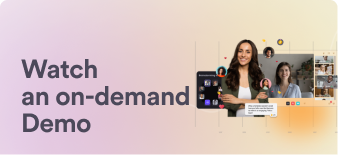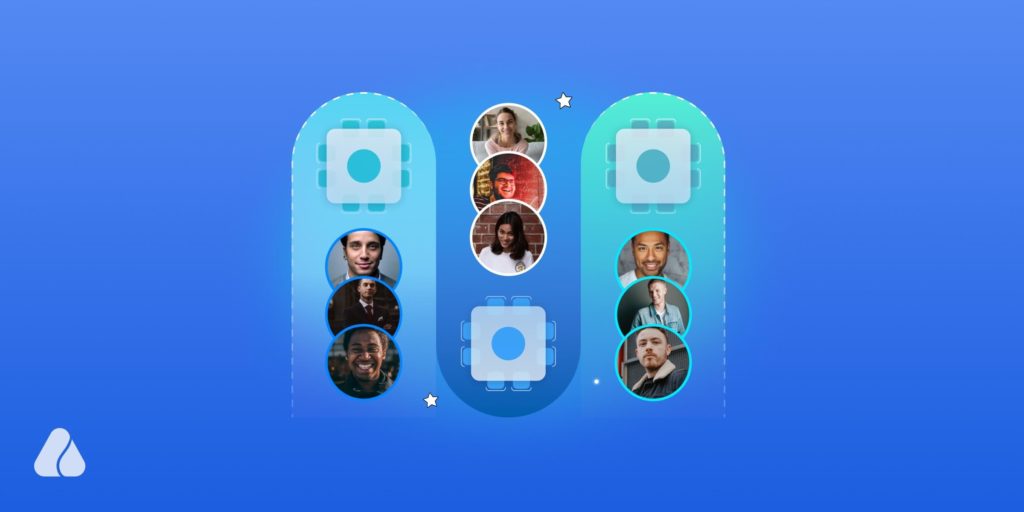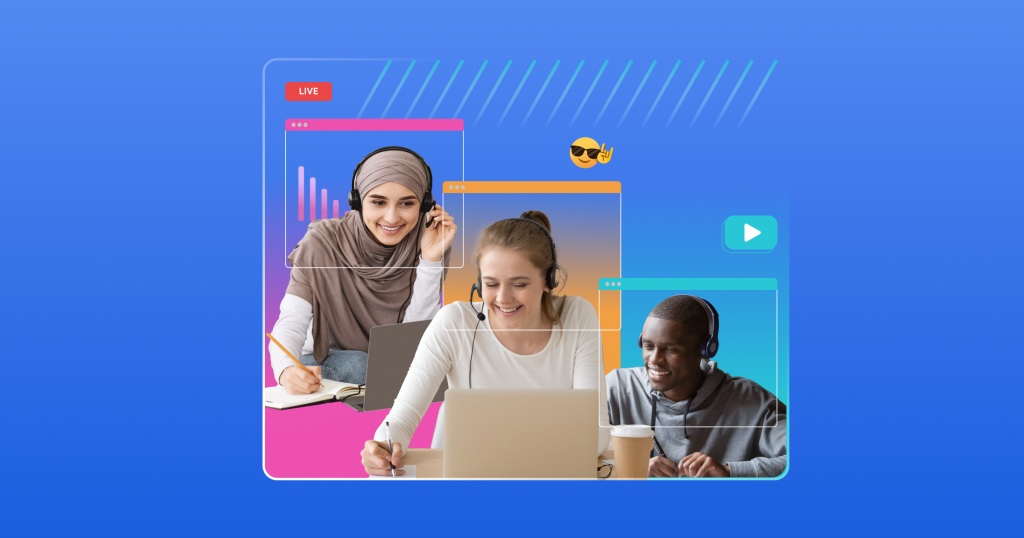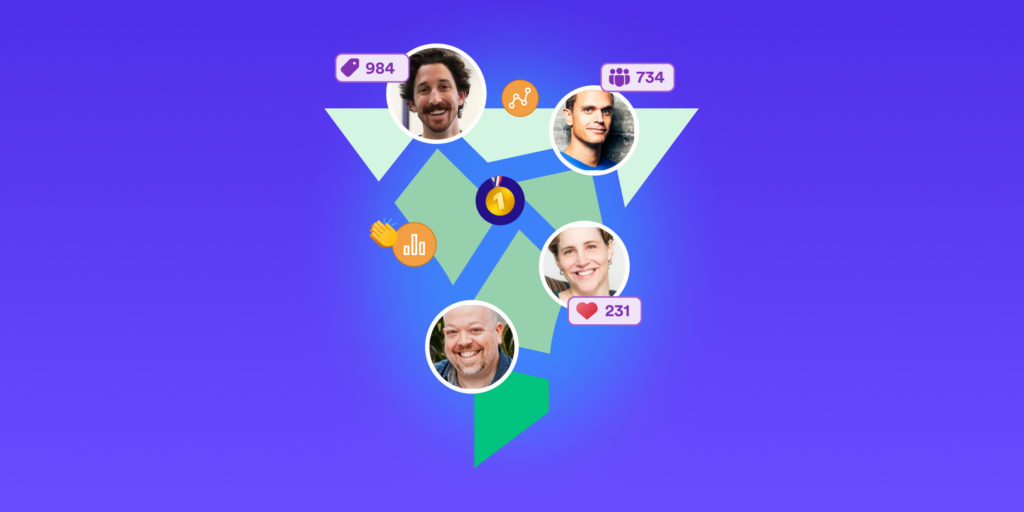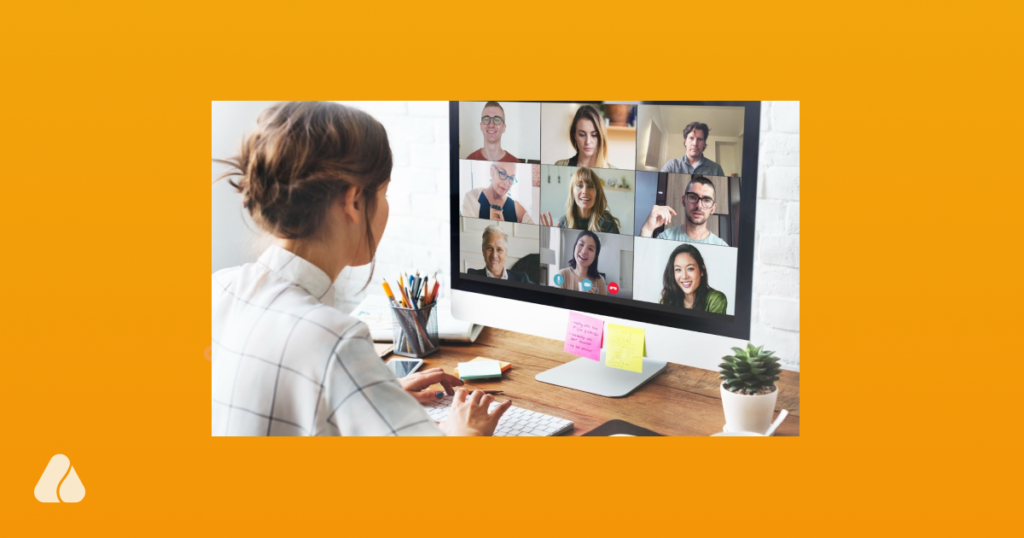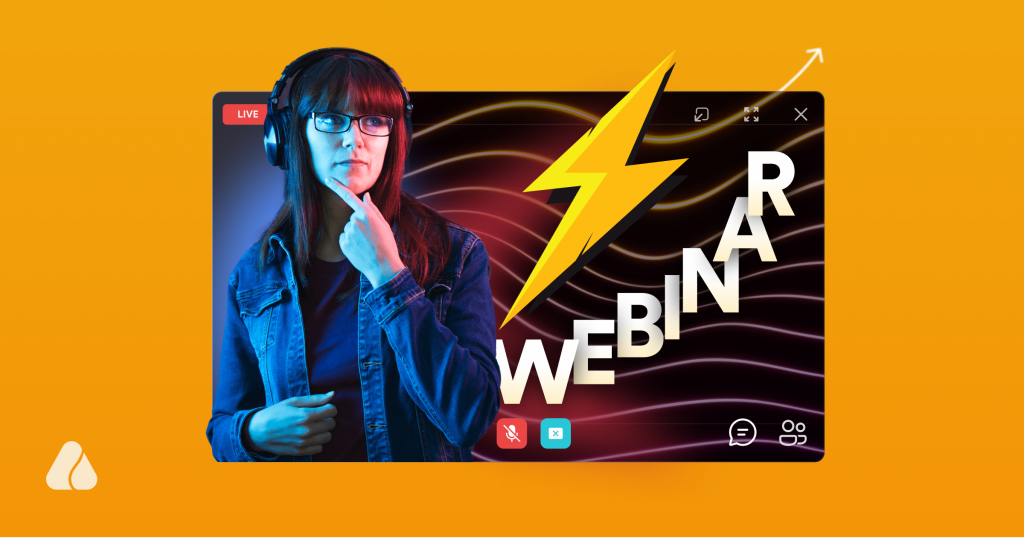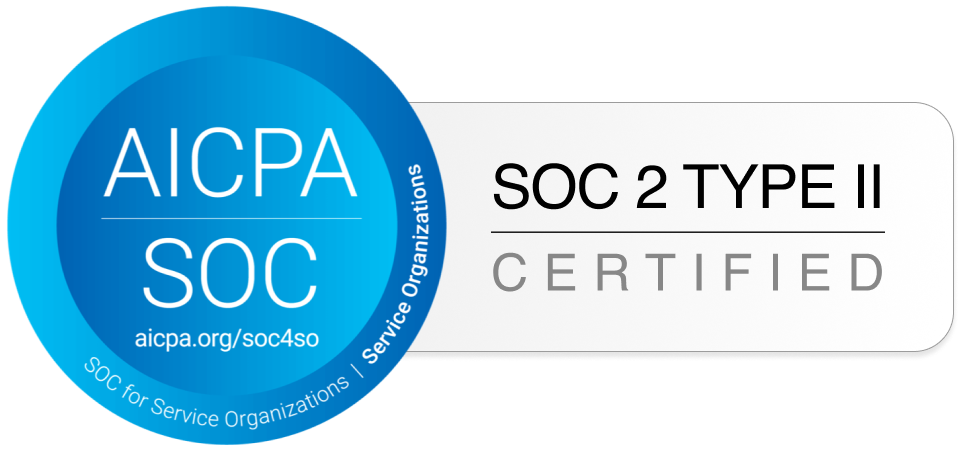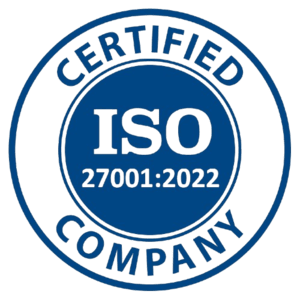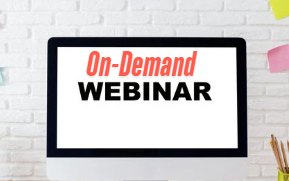
The registration process for a recorded webinar is similar to a live webinar. Upon registration, viewers can immediately access and watch the on-demand content. In fact, 63% of webinar views are on-demand (replay) and 5 out of 10 viewers only watch the replay of the webinar (46%).
In this post, we will look into what an on-demand webinar actually is its benefits how it differs from a live webinar how to promote it and more.
The webinar market is expected to attain an overall revenue of $800 million in 2025.
What is an On-demand Webinar?

An on-demand webinar is actually a pre-recorded session that viewers can watch at their own convenience. Unlike live webinars on-demand webinars are not streamed in real-time. They are typically recorded during live presentations and then made available for viewing later.
On-demand webinars contain the same valuable content as live webinars do, including presentation slides speaker recordings and even Q&A sessions. Registration for such webinars is open around the clock. Viewers can subscribe and access them at any time.
What are the Benefits of On-demand Webinars?

- Increased Reach: On-demand webinars significantly increase the reach of your content to a much larger audience. It allows you to promote and share it on multiple platforms further increasing its visibility to a potential audience.
By removing geographical barriers, it allows organizations to reach out to a global audience. Since it is a fully pre-recorded session anyone in the world can get access to it and watch it at their own time.
- Cost-Effective: On-demand webinars require fewer resources than live events. You don’t need to invest in expensive venues travel arrangements or on-site logistics. No need for additional staff and equipment to handle the technical issues in real-time.
It eliminates the need to pay for speakers, equipment, and other resources for each session. Due to its low-cost investment, it makes for a more budget-friendly option for businesses and organizations of all sizes.
- Data-Driven Insights: On-demand webinar platforms have robust analytics tools that allow you to track the behavior of your audience. You get detailed insights into specific segments of the webinar such as which parts of the webinar your audience watched, how long they stayed, which part they skipped, and where they dropped off.
You get a data-driven overview of your on-demand webinar that can really help you refine your content strategy, improve future webinars and gain a better understanding of your audience’s interests and preferences. Additionally, through data analytics, you are able to identify potential leads to nurture them through the sales funnel.
To learn more about tracking webinar metrics, check out this guide.
- Flexible & Accessible: When it comes to webinars, on-demand ones stand out with their unmatched flexibility and accessibility. Because they are pre-recorded, viewers can access the recording and learn the information whenever they want, regardless of how hectic their schedule is. Anyone with a stable internet connection can sign up for the on-demand course and stream the recorded session, anytime, anywhere.
- Reuse as Evergreen Content: On-demand webinars have a wealth of content that can be reused to increase their reach and value. You can repurpose it into various formats such as social media posts, blog posts, podcasts, e-books, etc. This approach will not only extend the lifespan of the webinar, but also make the content invaluable even after the event ends.|
To repurpose webinar content effectively, check out this full guide.
- Higher Lead Generation: On-demand webinars can serve as an effective lead magnet. You can offer valuable content and in exchange take their contact details to generate leads and grow your potential customer base.
When you make your webinars available at all times, you eliminate scheduling conflicts, increase accessibility, and allow prospective leads to interact with your content at their convenience, potentially generating more high-quality leads.
Additionally, by repurposing the content in your on-demand webinar, you increase its value and generate additional ongoing leads.
Difference Between On-demand and Live Webinar
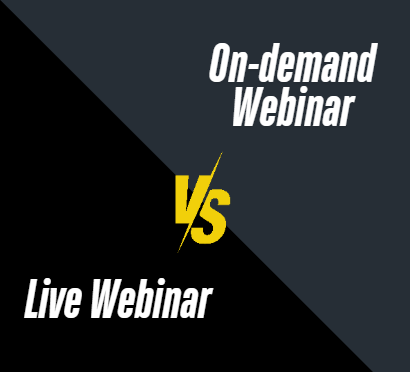
Live Webinar | On-demand Webinar | |
1 | Live webinars are virtual seminars where the host and audience interact, connect, and engage in real-time | An on-demand webinar is a replay of a live webinar, made available for viewers to access at their convenience |
2 | It is limited to those available to attend the session, at the scheduled time | It allows you to provide anytime, anywhere access to viewers and reach a wider audience, across time zones and schedules |
3 | Live webinars require the physical presence of people | As these sessions are pre-recorded, audiences need not be present live to watch them |
4 | It enables a high level of engagement with the audience, via chat, polls, and Q&A sessions | Viewers are not able to interact with the host directly |
5 | Live webinars still need some amount of investment for speakers/webinar software/gadgets/promotions/ etc | Compared to live webinars, the cost of an on-demand webinar is lower, but it still needs investment in video editing software and advertising |
6 | It generates leads but is limited till the live event is on | It continues to generate leads over time |
7 | There is a risk of technical glitches during the live session | Pre-recorded videos do not present any technical difficulties, as long as viewers’ internet connectivity is reliable |
8 | Best for launching new products or services and giving attendees a hands-on experience | Best for creating evergreen content and lead nurturing |
How to Create an On-Demand Webinar

- Define Your Webinar Goal: First, understand your end goal, whether it’s to generate leads, build brand awareness, showcase your product or service, or something else. Make sure the goal is specific, measurable, achievable, relevant, and time-bound (SMART). It will help you tailor your content and marketing strategy accordingly.
- Understand Your Audience: You’ve set a goal, now it is time to identify your target audience. It involves identifying their demographics, interests, and pain points. In order to get your message to the right audience, you need to have a thorough understanding of your audience. For that, you will need to conduct thorough market research, as well as create buyer personas, that represent your ideal customer.
For example, let’s say you’re a software company and you’ve built a tool that will produce content faster than ever. So, your target audience would be content marketing agencies, business owners, content creators, freelance writers, etc.
- Choose a Webinar Platform: To create on-demand webinars, you will need a platform that lets you host and record webinars as well. Consider Airmeet as it automatically records the live session. You can download the recording from its event dashboard.
Have a third-party recorder, like OBS Studio, for backup. It is a high-quality video recording solution that can record 4k videos with ease. This tool is accessible on operating systems like Windows, MacOS, and Linux.
- Structure Your Webinar Content: Next, outline the structure of your webinar content. Use slides, videos, graphics, and other multimedia elements to create engaging content.
Also, incorporate interactive elements like polls, chat, and Q&A to keep the audience engaged. At the end, include a clear call to action, such as downloading a resource or subscribing to a newsletter.
- Assemble All Required Equipment: Assemble all other essential equipment such as a laptop, microphone, headphones (noise canceling ones, ideally), good lighting, and high-speed internet. Ensure the webcam is functioning smoothly, as it is important to give your attendees a more personal and interactive experience. Additionally, leverage the video editing software to add transitions and trim the video clips to maintain the flow.
- Conduct a Test Run: Hold a trial session a day or two before the actual webinar. It will help you get familiar with the webinar platform and its features. Along with that, check the audio & video quality, screen sharing, recording capabilities, etc., to make yourself comfortable with using the platform during the live event.
- Host and Record the Webinar: On the scheduled date & time, host the live webinar on your chosen platform. Before the session begins, make sure it is getting recorded. As planned, welcome your attendees warmly, first. Then introduce them to the speaker, share the webinar agenda, deliver the presentation, inform attendees about your products or services, encourage them to participate in Q&A sessions, and get their feedback at the end. Stop recording once the event ends.
- Edit and Enhance Your Recording: You don’t want to upload the live webinar’s recording as is, for on-demand viewing. You’ll need to edit it, which means cutting out unnecessary segments of the video, adding graphics and animations if required, and removing any technical problems that might have stopped the session.
There are some video editing software available that you can use to enhance your webinar recordings including Adobe Premiere Pro, Final Cut Pro (for Mac users), DaVinci Resolve, and iMovie. These tools offer a variety of features, from trimming and cutting, to advanced color correction, audio mixing, and special effects. Choose the software that best suits your needs and budget.
How to Promote an On-Demand Webinar?

You will have to advertise it cleverly, if you want your on-demand webinar viewership to expand. Just as you would promote a live webinar, you need to promote an evergreen webinar too.
On-demand event content can be a panacea for ongoing lead creation. The more you promote it, the higher the chances of it reaching potential leads.
Let’s explore some ways to market your on-demand webinar, so you reach your intended audience, as quickly as possible.
1) Use Email Marketing:
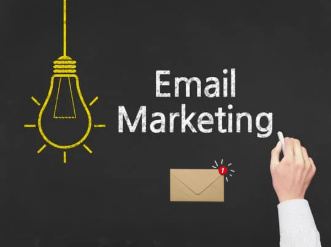
Leveraging email marketing is a great way to highlight the value proposition of your on-demand webinar. It is a highly effective channel to reach out to the target market and drive results.
57% of webinar registration comes from email marketing campaigns. That means this channel successfully converts 57 out of every 100 visitors into sign-ups. So it is evident by now, how crucial the role of email marketing is in promotional strategy.
The following is a simple guide to running an email marketing campaign:
- Build an email list of your existing leads/customers
- Craft a high-converting email sequence like the initial invitation, reminder email, follow-up email
- Craft a compelling subject line
- Personalize email by addressing the recipient by name
- Include eye-catching visuals, like images or infographics, in the body of the email
- Incorporate a strong call to action (CTA), like “Download Now”
- Monitor key metrics like open rates, click-through rates, and conversion rates to optimize future campaigns
2) Create a Blog Post:

Writing an engaging blog post on the on-demand webinar is a great way to reach out to audiences who enjoy absorbing information through written words.
According to this article, 70% of consumers prefer blogs over advertisements to learn about companies. And companies with blogs generate 67% more leads monthly. The pipeline of leads is greatly increased when you actively post articles on your official blog.
Furthermore, through blog posts, you can significantly increase your brand’s visibility in search engine results pages (SERPs). With a blog, you can actually generate interest in the webinar, and add a CTA button to redirect them to access the information through an engaging video content format.
3) Share across Social Media:

When it comes to expanding webinars’ viewership count, social media;s role is paramount. It gives an unparalleled opportunity to reach global audiences.
You can share your on-demand webinar session link on various platforms like Facebook, Instagram, LinkedIn, and X (formerly Twitter) with relevant hashtags, in order to increase its discoverability to new viewers.
To encourage your audience to sign up, you can create engaging posts in the form of videos where you highlight the benefits. Plus, you can run paid ads and reach out to more specific demographics.
4) Create a Podcast:
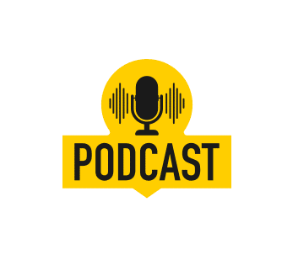
Turn your on-demand webinar content into a captivating podcast episode, and tap into a new audience of listeners who prefer the audio format. Podcasts have a lifespan similar to videos. People can listen to them over and over again anytime, and anywhere – which is why they remain relevant for longer periods of time.
When creating a podcast series, consider creating it on popular platforms like Spotify, Apple Podcasts, and YouTube, as they make up 64% of weekly podcast US listeners. YouTube ranks as a preferred platform for listening to podcasts according to 33% of monthly podcast listeners in the US, followed by Spotify (24%) and Apple Podcasts (12%).
5) Feature on the Landing Page:

A webinar landing page makes for an amazing lead magnet. Inserting your on-demand webinars on your landing page can significantly boost your lead-generation efforts. Plus, it will help create a more engaging user experience for your audience.
You can generate excitement among people to watch the webinar by putting a short teaser of your on-demand webinar on your landing page. By demonstrating the value of your webinar content right on the webpage, you can further encourage them to sign up for your evergreen webinar.
6) Share in Communities & Groups:

Promoting on-demand webinars in relevant online communities or groups can be a highly effective marketing approach. Such platforms often feature individuals with shared interests, which are ideal for reaching your target audience.
If you have a group on a popular social media site like Facebook or LinkedIn, or if you are part of a community that is designed to gain insight on a specific topic, share the link of your on-demand webinar there.
Why Should Webinars Be Made Available On-demand?
Attending live events can be challenging for each of your target audiences. It’s even harder if they’re in different geographical areas and time zones. In such a scenario, on-demand webinars become increasingly important because they offer a flexible and easy solution, making content more accessible than ever before. They not only extend the reach of your content but also its lifespan, enabling viewers to engage with whenever they want.
Which Format is More Effective: An On-demand Webinar or a Live Webinar?
Both formats have their own distinct strengths and benefits. The more effective format is the one that works for your specific business goals.
A live webinar is ideal for providing customers with a hands-on experience with your products or services while also collecting feedback in real time.
To build brand awareness over time and connect with a worldwide audience, an on-demand webinar is the preferred way to go.
Conclusion
An on-demand webinar serves as a powerful platform to share knowledge, reach out to a broader audience, and achieve marketing goals. It also holds the potential to generate quality leads for your organization.
On-demand webinars are preferred as they allow attendees to access them when it is most convenient for them. If you want to attract a larger audience, increase the reach of your content, and grow your business, consider on-demand content because it is a truly valuable tool in 2025 and will continue to be so.
FAQs
Airmeet is one of the best platforms for hosting webinars due to its focus on creating immersive and engaging virtual experiences. There are other platforms too like Zoom, GoToWebinar, Zoho, and Webex, but they all primarily focus on video conferencing. This is why Airmeet is considered the preferred choice for hosting webinars for businesses of all sizes.
In the coming years, on-demand webinars will leverage AI-driven personalization, providing learners with a more engaging, tailored, and relevant learning experience. Additionally, on-demand webinars will be more accessible to diverse audiences through features such as closed captions, multilingual subtitles, and screen reader compatibility.
No, that is not possible. Attendees will not be able to interact with the host during an on-demand webinar because they are watching a pre-recorded session. However, if attendees have any questions, they can submit them through the Q&A tool built into the webinar platform. The host will then respond to the queries accordingly.
You can offer downloadable resources such as webinar presentation slides, white papers, case studies, e-books, and checklists. Also, share relevant blog post links to redirect them to your company website.
There are numerous factors to consider when choosing an on-demand webinar platform, such as ease of use, interactive features (poll, chat & Q&A), data analytics & reporting capabilities, data security, and more. To learn additional factors, check out this complete guide.
You need reliable webinar software like Airmeet, a computer or laptop, high-speed internet, presentation software (like PowerPoint or Google Slides), an HD webcam, a video recording feature, and video editing software like Adobe Premiere Pro, Final Cut Pro, or even simpler tools like iMovie to edit and the quality of the recorded video.


